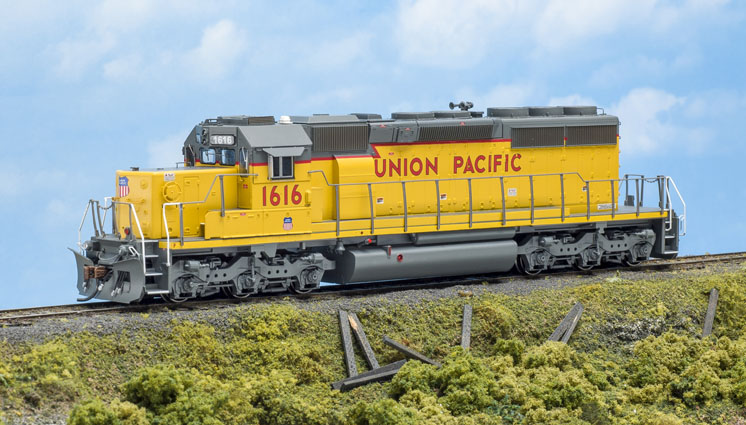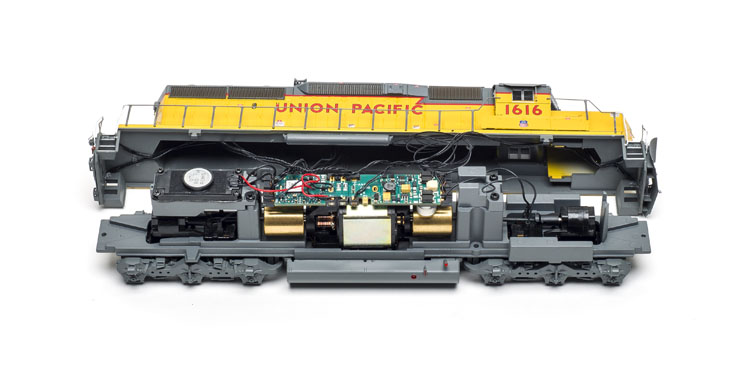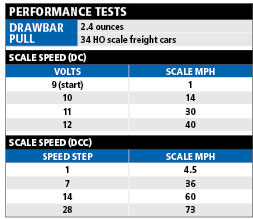Although it’s part of Athearn’s value-priced Ready-To-Roll series, this SD40-2 bristles with enough roadname-specific detail to satisfy most prototype-savvy modelers. The SD40-2 also marks a big upgrade for Athearn RTR locomotives. Instead of the SoundTraxx RTR decoder with limited functionality found in previous Athearn RTR releases, this new SD40-2 is available with a fully featured SoundTraxx Econami decoder.
The prototype. The SD40-2 is General Motors Electro-Motive Division’s best-selling locomotive of all time. Produced between 1972 and 1986, the SD40-2 featured a 3,000 hp turbocharged 645E diesel engine, modular electronic components, and high-adhesion HT-C trucks.
Beginning in 2010 and continuing through 2011, the Union Pacific RR modernized many of its SD40-2s with upgrades that included new emission control equipment and a NEXSYS computer control system. This latter feature also led to the locomotives being classed SD40N. On the UP these units are numbered 1550 to 1782, as well as some units in the 1800 and 1900 number series.
The model. Our review sample models UP no. 1616, an SD40N upgraded in 2011. The locomotive began its career in early 1977 as SD40-2 no. 3351.
The model’s overall dimensions match prototype drawings in Model Railroader Cyclopedia: Vol. 2, Diesel Locomotives (Kalmbach Books, out of print). The model includes the prototype’s extended short hood or “snoot” that was meant to house remote-control equipment that allowed the locomotive to be used as an unmanned helper.
The model has a scale 123″ long short hood, which is correct for snoots built after 1977 for other roads. All UP snoots, regardless of built date, had 116″ short hoods, according to author Don Strack (utahrails.net) and other sources.
I find that the scale 7″ difference is hardly noticeable. All other details on the model match prototype photos. Prototype-specific details include a cab air conditioner, correctly positioned Nathan K-3 air horn, and a GPS dome on the cab roof. The model also has a separately applied brake wheel on the short hood that’s correct for no. 1616.
All grab irons are separately applied. Handrails and stanchions are scale profile and made of flexible acetal plastic that resists breaking. There’s also a package of user-installed detail parts for modelers who want to add some additional piping around the fuel tank.
The lettering and heralds are clearly printed and properly placed. Small stencils are legible under magnification, including “SD40N” under the road number on the sides of the cab.
Mechanism. After removing the couplers I easily lifted off the plastic body shell. Be careful during this process, as the leads to the headlights and ditch lights remain attached to the shell. All lighting is provided by constant 1.5V incandescent bulbs.
The motor and flywheels are mounted in the center of the die-cast metal frame. Driveshafts transfer power from the motor to truck-mounted gearboxes.
On our DCC-equipped review sample, the SoundTraxx Econami decoder is attached to the chassis above the motor. The decoder is connected to a downward-facing rectangular speaker mounted above the rear truck gearbox.
All-wheel electrical pickup kept the lights and sounds steady as the SD40-2 crawled through no. 5 yard turnouts. During the hill climb test, the SD40-2 pulled a 10-car train up a 3 percent grade without slipping.
DCC operation. As shown in the charts above, the Athearn SD40-2 accelerated to a prototypical top speed of 73 scale mph. Setting the decoder’s speed steps to 128 allowed for finer slow speed control, including a 1 scale mph starting speed in step 1. All other aspects of the locomotive’s performance, including setting up speed tables and adding acceleration and deceleration momentum, are adjustable via programmable configuration variables (CVs). A free user manual is available at www.SoundTraxx.com.
I could also use CVs to adjust the overall volume level and the individual volume level of each sound effect.
The Econami decoder provides more user-triggered functions than the previous RTR sound decoder. In addition to the bell, horn, and headlight, there’s manual notching up and down as well as a coupler sound. The dynamic brake function turns on the dynamic brake fan sounds and drops the engine rpm, just like on a real locomotive.
I especially appreciate that the Econami has a working brake function. Following the instructions in the manual, I set up function 9 to trigger brake sound effects and stop the locomotive regardless of the throttle setting.
The Econami decoder also includes SoundTraxx’s Flex-Map technology, which is also found on the firm’s top-of-the-line Tsunami2 decoder. Flex-Map makes it easy to map functions to any available throttle key. Using Flex-Map and the decoder’s Hyperlight controls,I set up the locomotive’s headlights and ditch lights for non-directional control. I find manual locomotive lighting control to be much more realistic than directional lighting.
In addition to setting up the model’s address to match its locomotive number (1616), I set up an advance consist with two other DCC-equipped SD40-2s. The decoder supports consist function control, which comes in handy when m.u.-ing locomotives.
DC operation. The decoder-equipped SD40-2 ran smoothly on our direct-current (DC) test track, but required a lot of voltage to get moving, as shown in the charts above. The 40 scale mph top speed at 12V is lower than the prototype.
All sound effects in DC are automatic. The engine rpm increased and decreased with the throttle setting. I also heard the sound of squealing brakes when I decreased the throttle.
Upgraded with a SoundTraxx Econami decoder, the Athearn Ready-To-Roll HO scale SD40-2 is a winning combination of detail and performance.
Price: $184.98 (DCC sound), $134.98 (DC no sound)
Manufacturer
Athearn
1600 Forbes Way, Suite 120
Long Beach, CA 90810
www.athearn.com
Era: 2011 to present (as decorated)
Road names (multiple road numbers): Union Pacific, Canadian National, Illinois Central, Milwaukee Road, Missouri Pacific, and Soo Line
Features
• All-wheel drive and electrical pickup
• Dual-mode SoundTraxx Econami decoder (DCC version)
• Five-pole skew-wound motor with dual brass flywheels
• Minimum radius: 18″ (22″ recommended)
• Plastic McHenry scale knuckle couplers, at correct height
• Quick Plug supports 8- and 9-pin DCC decoders (DC version)
• RP-25 blackened metal wheels, in gauge
• Weight: 14.8 ounces

















I just picked up a pair of these recently at a local hobby shop for about $120 (DCC & Sound) each. I ran one for the first time this weekend and I was VERY impressed with the performance. That was purely out of the box changing only the loco address from default to run on my local club layout. I can’t wait to play with the settings and try it more.
I have numerous Athearn DCC / Sound SD40-2 locomotives. Great for the price. The details are good, they can run at very low speeds without hiccups, sound is great too. I have a couple with ditch lights and they light up but I can’t get them to flash, it might be me with my novice dcc experience. I rate them as 5 stars.